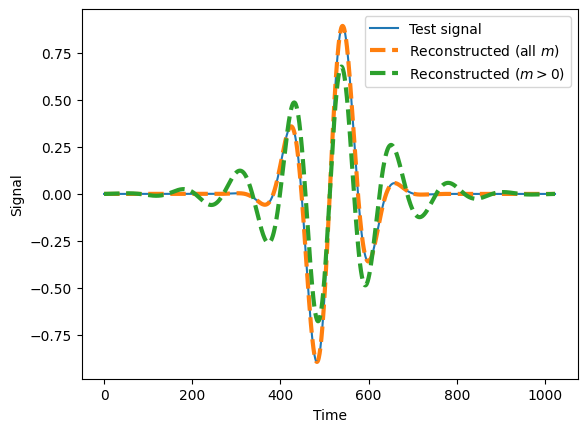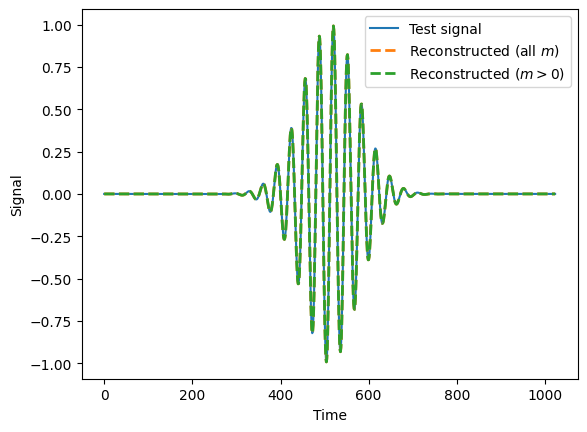m=0 Wavelet Coefficients
The wavelet basis is labelled by the indices \(n\) and \(m\);
The index \(m\) labels wavelets of different frequencies and varies in the range \(m\in\{0,1,\ldots,N_f-1\}\).
The terms with \(m=0\) include both the lowest frequency (\(f\approx 0\)) and the highest frequency (\(f\approx f_{\rm Nyquist}\)) wavelets. These terms need to be handled separately from the majority of the terms with \(m>0\). This slows down the wavelet transfrom.
However, very often the lowest and highest frequencies are not used for data analysis. E.g. when computing a GW log-likelihood we typically only integrate over a range \(f_{\rm low}\leq f \leq f_{\rm high}\) where the limits are chosen to be well inside the frequency range of the FFT.
For this reason the WDM_transform class is by default initialised with calc_m0=False. This will speed up the transformation but will get the calculations of the \(m=0\) terms wrong. If the \(m=0\) terms are needed, then set calc_m0=True.
[1]:
import numpy as np
import matplotlib.pyplot as plt
import WDM
[2]:
Nf = 32
N = 32*Nf
wdm_m_all = WDM.WDM.WDM_transform(dt=1, Nf=Nf, N=N, calc_m0=True)
wdm_m_geq0 = WDM.WDM.WDM_transform(dt=1., Nf=Nf, N=N) # default calc_m0=False
If we use the wdm_m_geq0 wdm transform to analyse a signal with lots of power at very low (or very high) frequencies then we will get the wrong result.
[3]:
f = lambda u, a: np.sin(a*np.pi*u) * np.exp(-0.5*u**2)
[4]:
test_signal_lowf = f((wdm_m_all.times-wdm_m_all.T/2)/(wdm_m_all.T/16), 1)
plt.plot(wdm_m_all.times, test_signal_lowf, label='Test signal')
reconstructed_m_all = wdm_m_all.idwt(wdm_m_all.forward_transform_short_fft(test_signal_lowf))
plt.plot(wdm_m_all.times, reconstructed_m_all, label=r'Reconstructed (all $m$)', ls='--', lw=3)
reconstructed_m_geq0 = wdm_m_geq0.idwt(wdm_m_geq0.forward_transform_short_fft(test_signal_lowf))
plt.plot(wdm_m_geq0.times, reconstructed_m_geq0, label=r'Reconstructed ($m>0$)', ls='--', lw=3)
plt.xlabel('Time'); plt.ylabel('Signal'); plt.legend(loc='upper right')
plt.show()

However, for signals where all the power concentrated is in the middle of the bandwidth it will work OK.
[5]:
test_signal_highf = f((wdm_m_all.times-wdm_m_all.T/2)/(wdm_m_all.T/16), 4)
plt.plot(wdm_m_all.times, test_signal_highf, label='Test signal')
reconstructed_m_all = wdm_m_all.idwt(wdm_m_all.forward_transform_short_fft(test_signal_highf))
plt.plot(wdm_m_all.times, reconstructed_m_all, label=r'Reconstructed (all $m$)', ls='--', lw=2)
reconstructed_m_geq0 = wdm_m_geq0.idwt(wdm_m_geq0.forward_transform_short_fft(test_signal_highf))
plt.plot(wdm_m_geq0.times, reconstructed_m_geq0, label=r'Reconstructed ($m>0$)', ls='--', lw=2)
plt.xlabel('Time'); plt.ylabel('Signal'); plt.legend(loc='upper right')
plt.show()

[ ]: